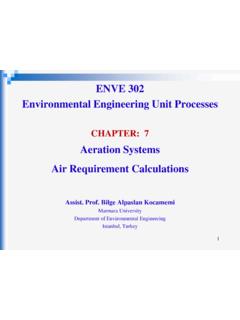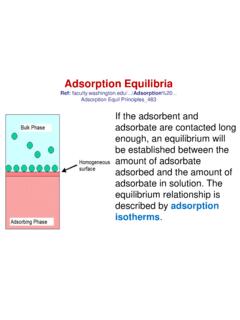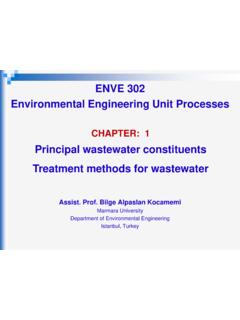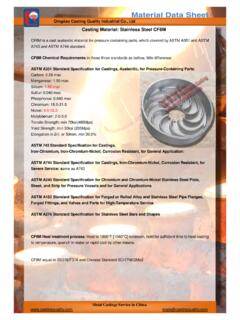Transcription of SAND, SAND ADDITIVES and SAND PROPERTİES - Marmara
1 sand , sand ADDITIVES , sand . PROPERTIES, and sand . RECLAMATION. Prof. Dr. Altan Turkeli MSE 432. Foundry Technology sand ADDITIVES . casting sand sand (SiO2 ). CLAYS (Bentonite ..). WATER. CELLULOSE (Wood flour, Cob flour ..). OIL CHEMICALS (Soda ash, Polymers .). REFRACTORIES (Alumina, Silica flour ). SOLUBLES (Corn flour, Corn sugar ). Flow Chart of a Metal casting System sand . sand . casting Sands Silica Sands Zircon Olivine Chromite Aluminum Silicates Silica Sands Most green sand molds consist of silica sands bonded with a bentonite water mixture. (The term green means that the mold, which is tempered with water, is not dried or baked.). The composition, size, size distribution, purity, and shape of the sand are important to the success of the mold making operation. Sands are sometimes referred to as natural or synthetic.
2 Natural or Synthetic Natural sands contain enough naturally occurring clays that they can be mixed with water and used for sand molding. Synthetic sands have been washed to remove clay and other impurities, carefully screened and classified to give a desired size distribution, and then reblended with clays and other materials to produce an optimized sand for the casting being produced. Because of the demands of modern high pressure molding machines and the necessity to exercise close control over every aspect of casting production, most foundries use only synthetic sands. Composition Foundry sands are composed almost entirely of silica (SiO2) in the form of quartz. Some impurities may be present, such as ilmenite (FeO TiO2), magnetite (Fe3O4), or olivine, which is composed of magnesium and ferrous orthosilicate [(Mg,Fe) SiO4].
3 Silica sand is used primarily because it is readily available and inexpensive. Quartz undergoes a series of crystallographic transitions as it is heated. The first, at 573 C, is accompanied by expansion, which can cause mold spalling. Above 870 C, quartz transforms to tridymite, and the sand may actually contract upon heating. At still higher temperatures (> 1470 C), tridymite transforms to cristobalite. Shape and Distribution of sand Grains The size, size distribution, and shape of the sand grains are important in controlling the quality of the mold. Most mold aggregates are mixtures of new sand and reclaimed sand , which contain not only reclaimed molding sand but also core sands. In determining the size, shape, and distribution of the sand grains, it is important to realize that the grain shape contributes to the amount of sand surface area and that the grain size distribution controls the permeability of the mold.
4 As the sand surface area increases, the amount of bonding material (normally clay and water) must increase if the sand is to be properly bonded. Thus, a change in surface area, perhaps due to a change in sand shape or the percentage of core sand being reclaimed, will result in a corresponding change in the amount of bond required. Rounded grains have a low surface area to volume ratio and are therefore preferred for making cores because they require the least amount of binder. However, when they are recycled into the molding sand system, their shape can be a disadvantage if the molding system normally uses a high percentage of clay and water to facilitate rapid, automatic molding. This is because rounded grains require less binder than the rest of the system sand . Angular sands have the greatest surface area (except for sands that fracture easily and produce a large percentage of small grains and fines) and therefore require more mulling, bond, and moisture.
5 The angularity of a sand increases with use because the sand is broken down by thermal and mechanical shock. The porosity of the mold controls its permeability, which is the ability of the mold to allow gases generated during pouring to escape through the mold. The highest porosity will result from grains that are all approximately the same size. As the size distribution broadens, there are more grains that are small enough to fill the spaces between large grains. As grains break down through repeated recycling, there are more and more of the smaller grains, and the porosity of the mold decreases. However, if the porosity of the mold is too great, metal may penetrate the sand grains and cause a burn in defect. Therefore, it is necessary to balance the base sand distribution and continue to screen the sand and use dust collectors during recycling to remove fines and to determine the proper bond addition.
6 Most foundries in the United States use the American Foundrymens' Society (AFS) grain fineness number as a general indication of sand fineness. The AFS grain fineness number of sand is approximately the number of openings per inch of a given sieve that would just pass the sample if its grains were of uniform size, that is, the weighted average of the sizes of grains in the sample. It is approximately proportional to the surface area per unit weight of sand exclusive of clay. Zircon Zircon is zirconium silicate (ZrSiO4). It is highly refractory and possesses excellent foundry characteristics. Its primary advantages are a very low thermal expansion, high thermal conductivity and bulk density (which gives it a chilling rate about four times that of quartz), and very low reactivity with molten metal.
7 Zircon requires less binder than other sands because its grains are rounded. The very high dimensional and thermal stabilities exhibited by zircon are the reasons it is widely used in steel foundries and investment foundries making high temperature alloy components. Olivine Olivine minerals (so called because of their characteristic green color) are a solid solution of forsterite (Mg2 SiO4) and fayalite (Fe2 SiO4). Their physical properties vary with their chemical compositions; therefore, the composition of the olivine used must be specified to control the reproducibility of the sand mixture. Care must be taken to calcine the olivine sand before use to decompose the serpentine content, which contains water . The specific heat of olivine is similar to that of silica, but its thermal expansion is far less.
8 Therefore, olivine is used for steel casting to control mold dimensions. Olivine is somewhat less durable than silica , and it is an angular sand . Chromite Chromite (FeCr2O4), a black, angular sand , is highly refractory and chemically unreactive, and it has good thermal stability and excellent chilling properties. However, it has twice the thermal expansion of zircon sand , and it often contains hydrous impurities that cause pinholing and gas defects in castings. It is necessary to specify the calcium oxide (CaO) and silicon dioxide (SiO2) limits in chromite sand to avoid sintering reactions and reactions with molten metal that cause burn in. Aluminum Silicates Aluminum silicate (Al2 SiO5) occurs in three common forms: kyanite, sillimanite, and andalusite. All break down at high temperatures to form mullite and silica.
9 Therefore, aluminum silicates for foundry use are produced by calcining these minerals. Depending on the sintering cycle, the silica may be present as cristobalite or as amorphous silica. The grains are highly angular. These materials have high refractoriness, low thermal expansion, and high resistance to thermal shock. They are widely used in precision investment foundries, often in combination with zircon. Bulk density =The mass of powdered or granulated solid material per unit of volume sand ADDITIVES . Water Water H0. 2. sand ADDITIVES . Clays Clays Bentonite, Southern (Ca Bentonite). Bentonite, Western (Na Bentonite). Fireclay Kaolin Clay The most common clays used in bonding green sand molds are bentonites, which are forms of montmorillonite or hydrated aluminum silicate. Montmorillonite is built up of alternating tetrahedra of silicon atoms surrounded by oxygen atoms, and aluminum atoms surrounded by oxygen atoms, as shown in Fig.
10 1. This is a layered structure, and it produces clay particles that are flat plates. Water is adsorbed on the surfaces of these plates, and this causes bentonite to expand in the presence of water and to contract when dried. sand ADDITIVES Clays sand ADDITIVES Clays sand ADDITIVES Clays Fireclay Fireclay consists essentially of kaolinite, a hydrous aluminum silicate that is usually combined with bentonites in molding sand . It is highly refractory, but has low plasticity. It improves the hot strength of the mold and allows the water content to be varied over greater ranges. Because of its high hot strength potential, it is used for large castings. It is also used to improve sieve analysis by creating fines whenever the system does not have an optimum wide sieve distribution of the base sand . However, because of its low durability, its use is generally limited.
















